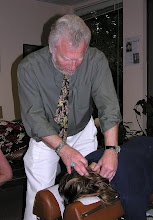This is NOT written by me. We have the honor of a guest blogger, Bill, Decken, D.C.,LCP, Chairman of the Federation of Straight Chiropractors and Organizations, Faculty, Sherman College of Chiropractic
All Professions Have an ObjectiveBill Decken, DC, LCP
Professions are defined by their objective, what it is they try to accomplish. Look at optometry. They are focused on the eye, no pun intended. However, the ophthalmologist is also focused on the eye. So what’s the difference? The Doctor of Optometry has the objective of examining visual acuity. In the process of doing so, he makes note of any abnormal findings that are revealed during the process of his exam. If there is something going on beyond the prescribing of corrective lenses for vision, he makes a recommendation to see a Doctor of Ophthalmology for further evaluation. The Doctor of Ophthalmology is a member of the medical profession and has the objective of treating diseases of the eye, which first need to be diagnosed. I have been to both a Doctor of Optometry and a Doctor of Ophthalmology and neither has ever examined my spine for subluxation, nor have they ever done a diagnostic workup on all of my body systems.
Similarly, in all my years of receiving dental care, my Dentists have never examined my spine for subluxation nor have they ever done a diagnostic work up to determine if my systems were functioning within textbook averages. The objective of the Dentist is to treat the conditions of the teeth and gums, which first require a diagnosis. When a Dentist recognizes a condition of misalignment of the teeth, outside the scope of what he does, he makes a recommendation to see an Orthodontic doctor, one whose objective is to straighten the teeth.
Medicine is divided into specialty areas so that the Medical Doctor can best diagnose and treat a variety of diseases and conditions, which is the medical objective. Again, there is no specialty in medicine that examines a person’s spine for subluxation.
In chiropractic, doctors have the option of choosing their objective. Some Chiropractors choose to diagnose and treat musculoskeletal conditions while others opt to examine the spine for subluxation and make an adjustment if necessary. These chiropractors can be said to be practicing straight chiropractic. If in the process of checking the spine the chiropractor notices anything outside the scope of practice, the patient is referred to the proper health care professional. The Chiropractor with the objective of locating and adjusting any subluxations is performing a service that is not duplicated by any other health care profession. It is a service that is proactive with regards to health care which is why so many families have a Chiropractor on their health care team.
Straight chiropractic care removes subluxations, maintains the brain to body connections and contributes to a healthy nerve system. A properly functioning nerve system helps people stay at their optimum level. Introduce others to chiropractic; the practice of straight, subluxation focused chiropractic is not an academic ideal, but the every day application of chiropractic principles.
Tuesday, April 26, 2011
Subscribe to:
Post Comments (Atom)
Popular Posts
-
My home state, New York, people speak plainer, more directly, than here in California. We have a saying, "Money talks. Nobody walks....
-
Sometimes, I just cannot stand the lies and distortion of the Accepted Ones... Medicine. The billions of dollars of drug ads on TV really st...
-
Last Saturday, I tried to do a good deed. I pulled into a gas station to fill up. I noticed in the car on the opposite side of the pumps was...
-
A Year of Medical Mental and Physical Damage… and Tyranny! PUBLISHED ON MARCH 9, 2021 Who would have thought that Big Brother would have ...
-
The story of how “They” killed my father-in-law. Joe was a fun guy. Enjoyed his vino and his cigars. Then, Kaiser got a hold of him. Th...
-
Treating Back Pain by Not Treating
-
Sunday is Father's Day. My thoughts go to my father, Fred Harte, who was killed, a long time ago, by medical indifference and stupidity...
-
"The school is public. The child is not." - BJ Palmer, D.C., Ph.C. It has long been a disgrace the extent to which the Califo...
-
Yes, the whole deal with cholesterol is myth. But it is myth with a purpose. It's purpose is to sell millions of dollars of statins, th...
-
It is funny to observe the thinking process of otherwise intelligent people when it comes to health. When offered chiropractic help, here ar...







No comments:
Post a Comment